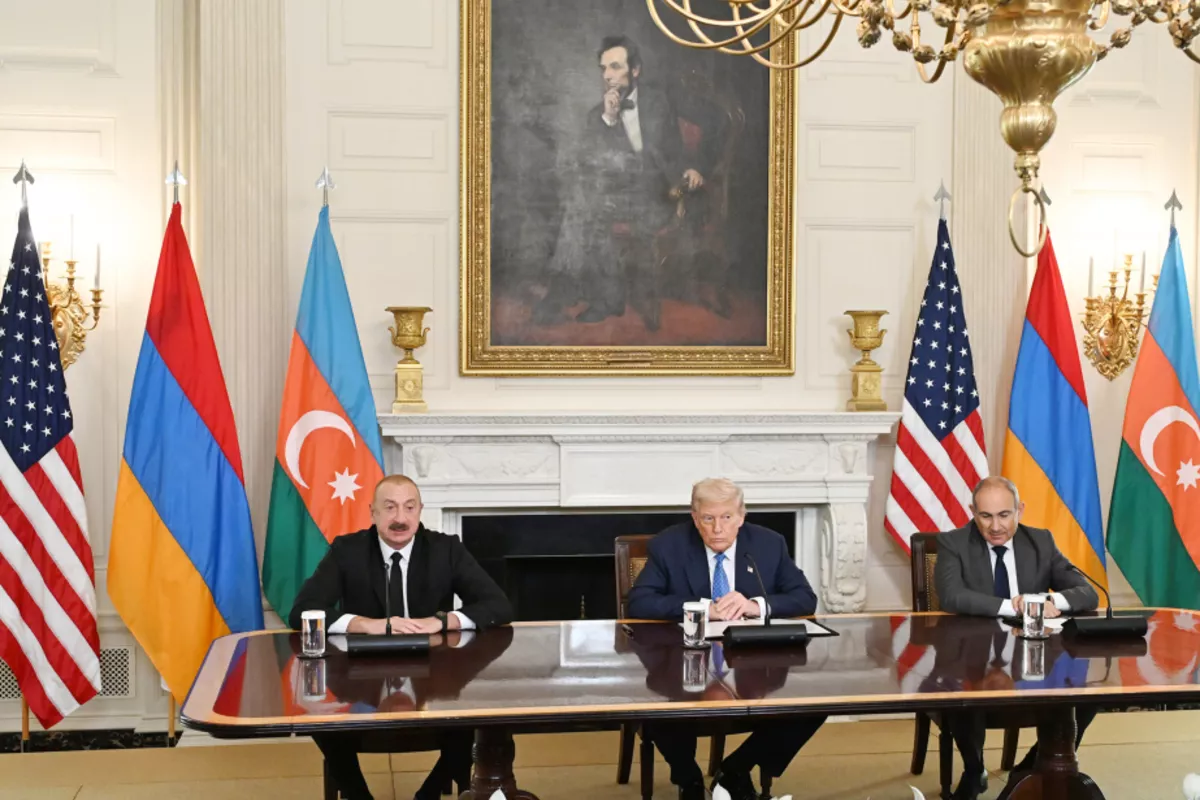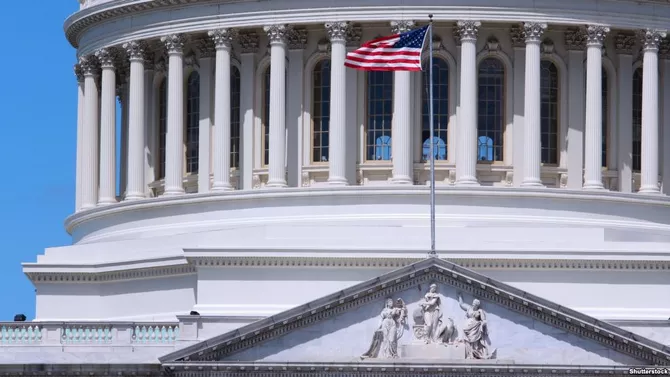
Photo: Azertag
The Washington meeting on August 7-8, 2025, between Azerbaijani President Ilham Aliyev, Armenian Prime Minister Nikol Pashinyan, and U.S. President Donald Trump marked a historic turning point in the decades-long search for peace in the South Caucasus.
Held at Trump’s invitation, the talks resulted in a seven-article joint declaration, the paraffing of a comprehensive 17-article peace treaty, and commitments to remove remaining obstacles to lasting stability. The meeting also produced major bilateral outcomes, including the signing of a Memorandum of Understanding to establish a Strategic Partnership Charter between Azerbaijan and the United States, covering cooperation in energy, trade, connectivity, digital transformation, artificial intelligence, and defense.
Trump’s decision to suspend Section 907 underscored Washington’s recognition of Azerbaijan’s strategic importance. A key highlight was the agreement to open the Zangezur corridor (Trump Route for International Peace and Prosperity - TRIPP), ensuring unimpeded transit between Azerbaijan and Nakhchivan, with potential to transform the Middle Corridor linking Europe and Asia.
While the agreements signal new geopolitical realities and enhanced U.S. influence in the region, reactions from Russia and Iran reveal the broader strategic stakes. The Washington meeting stands as a milestone toward lasting peace, provided its commitments are implemented and integration efforts continue without delay.

Sultan Zahidov, Senior Advisor at the Center of Analysis of International Relations (AIR Center), told The Caspian Post that the decades-long quest for lasting peace in the South Caucasus-shaped by geopolitical rivalries, deep-rooted conflicts, and missed opportunities-reached a decisive turning point in March-August 2025 as Azerbaijan and Armenia advanced toward a historic settlement, culminating in the landmark Washington meeting.
"Throughout history, establishing lasting peace in the South Caucasus has been one of the most challenging issues for states and international organizations. Situated at the crossroads of Eurasia’s critical geostrategic lines and known as a “geopolitical shatter belt,” the region has long remained a place where the interests of regional and global powers collide. The attempts of external powers to draw dividing lines in the region and to follow a divide et impera strategy have not only failed to end conflicts, but have, on the contrary, further inflamed them. The re-ignition of existing conflict hotspots in the region after the collapse of the Soviet Union also stemmed from this very rhetoric.
The Pandora’s box of the South Caucasus-full of conflicts and wars-was undoubtedly the nearly 30-year-long Armenia-Azerbaijan conflict, which resulted in the occupation of 20% of Azerbaijan’s territory and the displacement of nearly one million refugees and internally displaced persons. With the Second Karabakh War in 2020 and the anti-terror operations in 2023, Azerbaijan closed this box by liberating its territories from occupation, ending separatism, and restoring its territorial integrity and sovereignty. By doing so, Azerbaijan not only created new geopolitical realities in the region but also opened long-awaited opportunities for peace. Since then, although official Baku has put forward five principles for peace and sought to advance the process on various platforms (Brussels, Moscow, Washington), the geopolitical lens of mediators and Armenia’s destructive position prevented the goal from being reached.

Photo: Ministry of Foreign Affairs of the Republic of Azerbaijan
Finally, in March 2025, the foreign ministers of Azerbaijan and Armenia agreed on the articles of a peace treaty titled “On the Establishment of Peace and Inter-State Relations.” Subsequent meetings between the leaders of the two countries-first in Tirana and later in Abu Dhabi-signaled that normalization would accelerate. The turning point in the peace process came with the Washington meeting.
On August 7-8, at the invitation of U.S. President Donald Trump, Azerbaijani President Ilham Aliyev and Armenian Prime Minister Nikol Pashinyan visited Washington for an official working meeting and held talks with President Trump. The meeting produced a joint declaration of seven articles, which holds particular significance for establishing peace after years of conflict between Azerbaijan and Armenia. It should be noted that prior to the trilateral meeting, President Trump held bilateral talks with both Ilham Aliyev and Nikol Pashinyan, during which the United States signed important documents with both states," he added.
According to him, the Washington meeting is significant in several respects. First and foremost, the signing of a Memorandum of Understanding on the creation of a Strategic Working Group to prepare the U.S.-Azerbaijan Strategic Partnership Charter should, as President Ilham Aliyev noted, be considered a “new page” in the history of relations between the two countries. "Since independence, U.S.-Azerbaijan relations have been marked by ups and downs. The adoption of Section 907 of the U.S. Freedom Support Act by Congress in 1992 gave a negative impulse to the relationship. However, President Heydar Aliyev’s first official visit to the United States in 1997 elevated the ties to a new level. During that visit, important agreements were signed between Azerbaijan and the United States, including contracts with Chevron, Exxon, and Mobil for the development of the Absheron, Nakhchivan, and Oghuz oil fields in cooperation with SOCAR.
Nonetheless, especially during President Biden’s term, Washington’s disregard for balance in its Caucasus policy was marked by tensions. The reinstatement of Section 907, prohibiting any U.S. assistance to Azerbaijan, Secretary Blinken’s negative statements toward Azerbaijan, and Biden’s stance more aligned with Armenia prevented Baku from engaging Washington in the peace process with Armenia. The August 8 Washington meeting between Ilham Aliyev and Donald Trump was therefore important not only for healing the wounds from the Biden administration era but also for elevating bilateral relations to the highest level.
The signed Memorandum of Understanding envisages cooperation between the two countries in energy, trade, connectivity, digital transformation, artificial intelligence, the defense industry, and other areas. Moreover, President Trump’s decision to suspend Section 907 can be seen as a sign of Washington’s recognition of Azerbaijan’s strategic importance in the region and its commitment to advancing bilateral relations, as the section had long been considered one of the main obstacles to developing ties."

Photo: Reuters
Mr Zahidov stated the another factor that made the Washington meeting important was the signing of a joint declaration by the leaders of Azerbaijan and Armenia in the presence of the United States: "Most notably, the declaration affirmed that the parties had initialed the peace treaty text, thus officially confirming that both sides agreed to all 17 articles of the treaty. The declaration also stated that both sides would take the necessary steps toward signing the final peace agreement.
The main obstacle here is the clause in Armenia’s constitution containing territorial claims against Azerbaijan; in the name of lasting peace, Azerbaijan had made the removal of this clause a condition for Armenia. The declaration also enshrined another Azerbaijani condition-the dissolution of the OSCE Minsk Group and its institutions, which no longer serve any practical purpose-by agreeing that the foreign ministers of both countries would send a joint request to that effect. In short, the joint declaration should be seen as a key step in eliminating the remnants of the conflict, removing existing obstacles in a short time, and thus achieving lasting peace between the two countries and in the entire region.
Another important point in the declaration is the opening of the Zangezur corridor, which Azerbaijan has proposed since 2020. Under the name “Trump Route for International Peace and Prosperity” (TRIPP), this transport route will ensure unimpeded transit between Azerbaijan and Nakhchivan and has the potential to become a key element of the “Middle Corridor” linking Türkiye and Central Asia, Europe, and China. According to the agreement between the United States and Armenia, TRIPP will be managed by a U.S. company for 99 years, and various foreign companies will invest in infrastructure development around the corridor. Opening this corridor is important not only for connectivity but also, and more crucially, for establishing lasting peace in the region. Lasting peace depends on integration, and integration requires trade, connectivity, and open borders.
At the same time, the achievements of the Washington meeting will contribute to a shift in the balance of power and the geopolitical map of the South Caucasus. These developments increase the likelihood that the United States will enhance its influence in the new South Caucasus and gain new geopolitical levers through the TRIPP project. For this very reason, some voices of protest have already been heard from official circles in Russia and Iran. Viewing the United States as a geopolitical rival, its consolidation in the Caucasus as a threat, and TRIPP as an obstacle to the North-South Corridor, Tehran and Moscow’s negative reaction to the outcomes of the Washington meeting does not change the existing reality but does not rule out new confrontations in the region, which could, above all, damage the region’s security architecture.
In short, the Washington meeting can be regarded as a significant milestone both in the development of U.S.-Azerbaijan relations and in establishing lasting peace between Azerbaijan and Armenia and in the South Caucasus as a whole. However, it is essential that the agreements reached at the meeting be fully implemented, that work on opening the Zangezur corridor intensify, and that Armenia amend its constitution without delay. At the same time, the geopolitical consequences of the Washington meeting-particularly Russia and Iran’s approach to the matter and the steps they may take-should also be taken into account within the framework of advancing the Washington process."
Share on social media